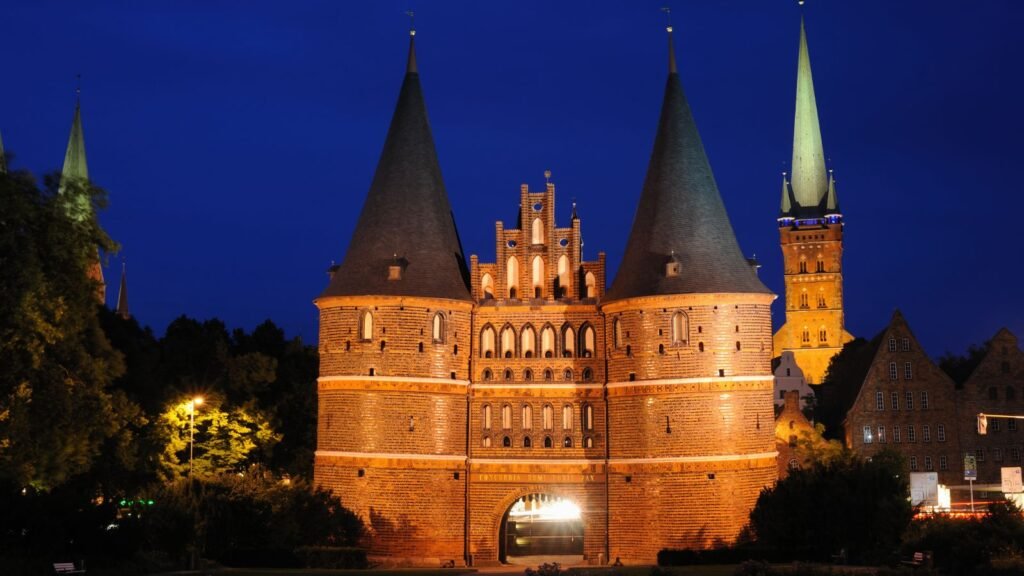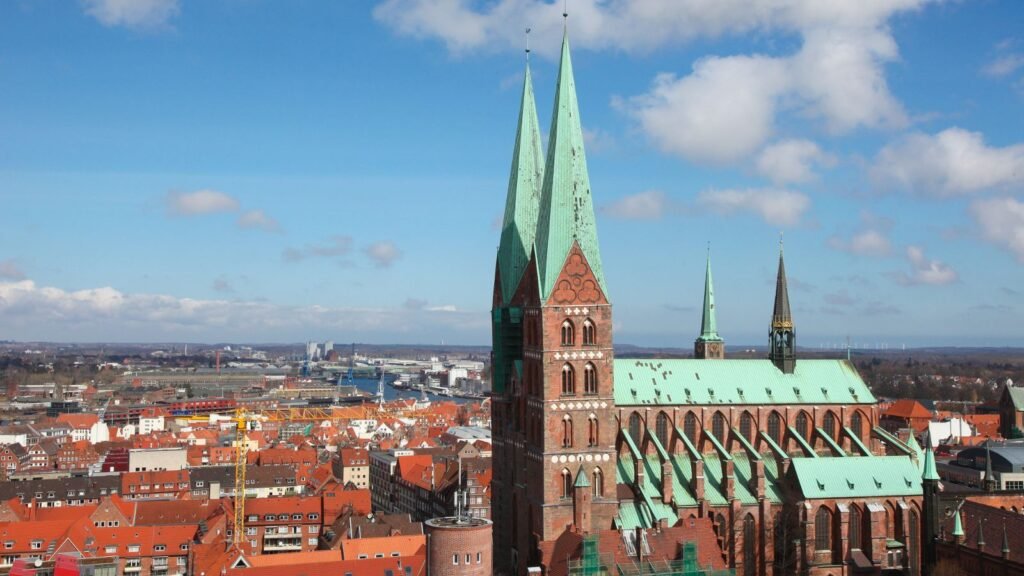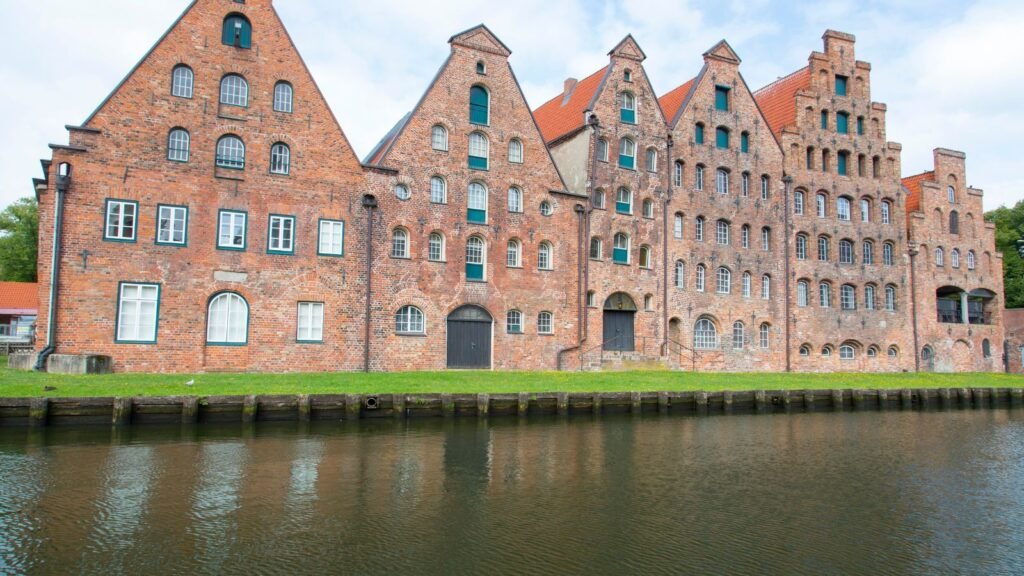Arrive in Lübeck with exactly zero expectations and a suitcase full of layers, because Baltic weather plays by its own rules and delights in unpredictability. If you’re planning to spend 48 hours in Lübeck, you’re in for a crash course in Hanseatic pride, marzipan devotion, and architecture that leans just enough to look dramatic in photographs. The city once bossed around half of Northern Europe as the Queen of the Hanseatic League, a title that sounds made up until you see the size of its medieval ego. But don’t let the ancient bluster fool you. These days, Lübeck feels more like a history nerd who moonlights as a marzipan enthusiast with a penchant for gothic brickwork and philosophical debates over coffee.
Start your first morning at the Holstentor, the stout twin-towered gate that screams “I am very important and also slightly leaning.” It’s Lübeck’s answer to the Arc de Triomphe, if the Arc had a diet of rye bread, salt wind, and existential anxiety. Stroll beneath it and imagine merchants of yore swaggering in, pockets jingling with trade coin and self-satisfaction. On the other side: the Altstadt, or Old Town, wrapped in a lazy loop of the Trave River and packed with more gothic gables than you can shake a steeple at. Every corner reveals a new oddity—a crooked alley, a hidden courtyard, a windowsill with a cat that looks deeply unimpressed with your itinerary.

Wander along the pedestrianised Breite Straße, past the town hall that looks like a fairy tale got stuck in construction and decided to stay. Pause to spot the bullet holes and patches from the Second World War, which are politely preserved as historical reminders rather than tidied up for Instagram. Duck into St. Mary’s Church (Marienkirche), where the devil allegedly helped build it—a long story involving bricks, misunderstandings, threats, and very medieval logic. Inside, find the broken bells that fell during a bombing raid and were left exactly where they landed, frozen in mid-crash. Lübeck doesn’t do revisionist history. It prefers to let the ruins speak.
Time for sustenance, and there’s really only one acceptable destination: Niederegger. This is marzipan’s spiritual home, with a shop and café so sugar-drenched it practically hums in a minor key. The display windows look like dessert museums curated by elves with a sweet tooth and too much time. Grab a marzipan cappuccino, a slab of nut-studded cake, or, if you’re feeling particularly brave, a marzipan potato. Not a real potato. It just looks like one, because German humour, while subtle, often involves food masquerading as other food.

If the sun deigns to appear, meander towards the Trave River and find the Museum Harbour, a delightfully under-marketed cluster of historic ships that bob gently with pride. Half of them are technically still seaworthy, though they mostly appear in parades or when someone forgets to tie a rope properly. If no one official is watching, you might be able to climb aboard. If someone is watching, just look deeply nautical and pretend you know how sails work.
Keep walking to the Hospital of the Holy Spirit (Heiligen-Geist-Hospital), which sounds either like a 70s horror flick or a Renaissance spa retreat. It’s actually one of the oldest social welfare institutions in Europe, complete with a vaulted chapel that smells faintly of old hymnals and well-meaning bureaucracy. Peek behind the little wooden doors inside—these were the monk-approved living cubicles for the elderly and infirm. A medieval retirement home, essentially, with fewer bingo nights and more incense.
For dinner, take a punt on Fangfrisch. This cosy haunt serves Baltic fish that doesn’t taste like it’s been rescued from a briny abyss of regret. Order the smoked mackerel, pair it with a cold Flensburger pilsner, and try to stop yourself from launching into impromptu sea shanties. You won’t succeed.

Morning two of your 48 hours in Lübeck. You’re not hungover, just mildly stunned by the amount of Hanseatic ambition packed into one city. Remedy that with a sunrise walk along the Obertrave embankment, where early light spills across the water and bathes the brick facades in a smug glow. Take a detour down Fischergrube or Glockengiesserstraße, where crooked buildings lean conspiratorially. Snap a photo of the Salzspeicher, those twisted old salt storehouses that look like gingerbread houses that gave up on being cute and went into trade instead.
Drop by the Willy-Brandt-Haus next. Yes, that Willy Brandt. Lübeck’s most famous chancellor, Cold War master of detente, Nobel Peace Prize winner, and walking embodiment of the phrase “serious but approachable.” The museum is unexpectedly gripping, with just the right amount of political drama, Cold War intrigue, and oversized eyewear. You may leave wanting to write an op-ed or start a coalition.
Now it’s time to spiral into the literary with the Günter Grass-Haus. Part museum, part shrine, and part fever dream, it celebrates the life and works of Lübeck’s other Nobel laureate. Expect surreal illustrations, existential sketches, and typewriters that radiate silent judgement. The permanent exhibition is like wandering through a brilliant but slightly disturbed imagination, which is exactly the point. Occasionally you’ll stumble upon a discussion group dissecting postwar guilt over filter coffee and rye bread.
Lunch calls for Kartoffelspeicher. As the name suggests, it’s an ode to the potato in all its starchy glory. Potato pancakes, potato dumplings, potato soup, potato dreams. If they had potato wallpaper, you wouldn’t be surprised. Order generously and don’t be afraid to try something ridiculous. You might find yourself wondering why anyone ever eats rice.
The afternoon adventure calls for a trip to Travemünde, Lübeck’s beachy alter ego. Hop on a bus or embrace your mortality with a borrowed bike. This Baltic seaside resort has seen better days and seems entirely fine with that. Wander the promenade, watch the ferries heave themselves toward Sweden, and observe the architectural crimes of 1970s beachfront hotels with morbid fascination. If the weather cooperates, brave a paddle in the sea. It’s cold. It always is. But you’ll earn bragging rights for life.
Don’t leave Travemünde without trying a Fischbrötchen. These herring sandwiches are brisk, salty, assertive—much like the region itself. They come with onions, pickles, mustard, and possibly the judgment of the woman selling them. Eat by the pier while dodging seagulls and wondering whether you’re falling in love with the fish or just really, really hungry.
Back in town, settle into Tonfink for the evening. This bar-slash-cultural-experiment is where Lübeck’s cool kids and oddballs converge over wine and jazz covers. You might walk into a poetry slam, or an accordion tribute to Radiohead. There may be lanterns. There will definitely be beanies. Sip something vaguely herbal and nod along like you understand German spoken-word.
Final morning of your 48 hours in Lübeck. Time to indulge at Cafe Affenbrot, a sourdough bakery that feels like it was designed by a co-op of idealistic bakers and recovering backpackers. The breakfast platter arrives like a miniature picnic assembled by a nutritionist with a boho soul: labneh, three kinds of jam, goat cheese, carrot salad, a boiled egg with aspirations, and some seeds you will find in your bag for weeks. It’s delicious. It’s mysterious. It’s very Lübeck.
If you’ve got a few hours left, the European Hansemuseum is a fitting grand finale. Don’t worry—it’s not just for maritime trade obsessives. The exhibits are immersive, the wax figures are unsettling in the best way, and the underground archaeological dig site looks like a medieval crime scene frozen in time. You may even find yourself whispering the phrase “economic maritime hegemony” like it’s a secret spell.
Wander back through the Altstadt one last time and get gloriously lost in the Gänges—the medieval alleyways that slink behind the grander buildings. They’re narrow, wonky, and deliciously off-kilter, with ivy-covered walls and windows peering out like nosy neighbours. Locals live here, so keep your commentary to a whisper and your camera clicks discreet.
Lübeck doesn’t shout. It sidles up with a grin, offers you something sweet and slightly eccentric, then ambushes you with its charm through crooked rooftops, literary ghosts, and an unapologetic love of marzipan. 48 hours in Lübeck go by fast—but you’ll be scheming a return. This time, with a larger suitcase, better walking shoes, and a suspicious amount of potato-related souvenirs.
